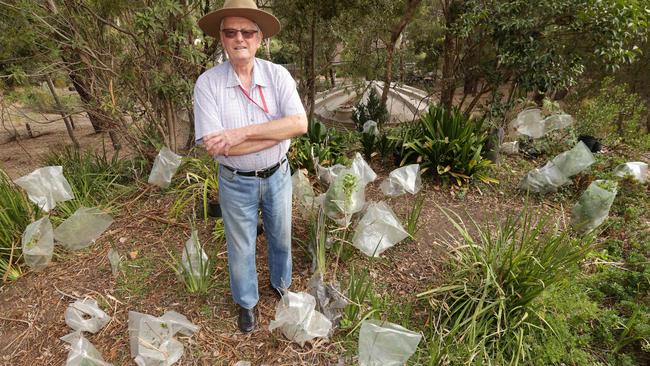Feral deer moving closer into city, posing risks to environment and motorists
A war on wild deer is brewing on Melbourne’s northern fringe, with the feral animals destroying gardens, colliding with cars and even fouling dam water. And the problem is getting worse.

North
Don't miss out on the headlines from North. Followed categories will be added to My News.
Feral deer are stampeding through properties, knocking down fences, destroying gardens and posing a huge risk for motorists.
And the problem is rife throughout the outer-rural areas of Nillumbik to the urban pockets — even as close to the city as the Yarra River.
Eltham homeowner Fred Bauer said deer were causing havoc on his property during the night, leaving him to wake up to a huge mess every morning.
Zac Thiessen’s car destroyed in feral deer incident
Feral deer, pigs and goat populations threaten biosecurity systems
“At least 30 metres of my rear fence has been knocked down, they are eating and destroying my plants, pulling down branches — our home is being denuded,” he said.
“And everything they eat comes out the other end — every morning there are droppings all over the lawn and I have to clean it up.
“It is unsightly and soul-destroying for us — we have been here for 40 years and our garden is just a wreck.”
Mr Bauer said feral deer had been an issue at his Pitt St home for the last two years, but had seen the problem escalate in the last few months.
“We have a serious problem with deer here, there is no question about it,” he said.
“We’ve tried plastic bags and wire fences, but it’s done nothing to stop them.”
Nillumbik Shire Council mayor Karen Egan said feral deer were a “serious issue” from Kinglake to the banks of the Yarra River.
She said her eldest daughter was lucky to be alive after smashing into a deer near Eltham College two weeks ago.
The 32-year-old’s car spun 180 degrees and narrowly missed an oncoming truck.

Cr Egan also hit a deer while driving along Smiths Gully Rd about 18 months ago.
“Hitting one is like hitting a bull,” she said.
“There was a death in New South Wales and it’s only a matter of time before there is one here.
“The way they breed enables their population to double every two years and it’s currently out-of-control.”
Help for Wildlife founder and volunteer Sue Kirwan said call outs for deer had doubled in the last 12 months.
“You can be killed quite easily if you hit one — they can bounce across the bonnet and into the windscreen,” she said.
“They’re also really dangerous when injured — adrenaline kicks in and they will try to have a go at you.”
Ms Kirwan said a major cull needed to happen.
“They’re (deer) getting further into the urban areas now and people don’t realise because they are really timid animals — they’re very good at hiding, keeping still and watching until suddenly one skips across the road,” she said.

Cr Egan said deer also posed many risks to the environment.
“At my property I had all these gum trees that were dying and then I realised they were being strip-barked by all the deer,” she said.
“They destroy vegetation and cause significant financial hardship on rural landowners because of all the crops they damage.”
Cr Egan said deer were often found within Nillumbik catchment areas and posed a high risk to the water quality from the degradation of banks and introduction of parasites.
“The first thing that needs to happen is we need to declare them as a pest then start looking at home we can reduce their population.”
She said deer were a very expensive animal to get rid of and called for alternatives to shooting.
“We must consider baiting, biological and genetic controls, trapping options, feeding stations and deterrents,” she said.
The peri-urban councils of Nillumbik, Manningham, Cardinia and Yarra Ranges requested the State Government’s Victorian Deer Management Strategy goal must be a reduction in deer numbers and immediate mitigation of their negative impacts.
A parliamentary inquiry into the control of invasive animals on crown land in 2017 recommended an “explicit strategy to contain and limit the spread of deer”.
A second recommendation suggested “one government body that has overall responsibility and accountability for invasive pest animal control in Victoria”.
Minister for Energy, Environment and Climate Change Lily D’Ambrosio said the latter recommendation was “supported in principle” by the State Government.
“It recognised that the best way of improving outcomes was through the establishment of an inter-agency invasive species committee to provide a strategic, integrated and co-ordinated approach to invasive species outcomes across all tenures,” she said.
“Consequently the Vic Inter-agency Invasive Species Committee has since been established.”
Ms D’Ambrosio confirmed deer species were increasing and spreading to urban areas of Melbourne and said a Deer Management Strategy was being developed.


